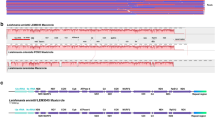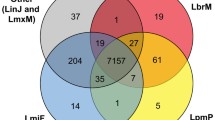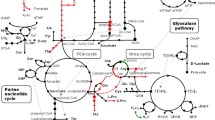Abstract
The maxicircle control region [also termed divergent region (DR)] composed of various repeat elements remains the most poorly studied part of the kinetoplast genome. Only three extensive DR sequences demonstrating no significant similarity were available for trypanosomatids (Leishmania tarentolae, Crithidia oncopelti, Trypanosoma brucei). Recently, extensive DR sequences have been obtained for Leishmania major and Trypanosoma cruzi. In this work we have sequenced DR fragments of Leishmania turanica, Leishmania mexicana, Leishmania chagasi and two monogenetic trypanosomatids Leptomonas seymouri and Leptomonas collosoma. With the emergence of the additional extensive sequences some conserved features of DR structure become evident. A conserved palindromic sequence has been revealed in the DRs of the studied Leishmania species, L. seymouri, and T. cruzi. The overall DR structure appears to be similar in all the Leishmania species, their relative L. seymouri, and T. brucei: long relatively GC-rich repeats are interspersed with clusters of short AT-rich repeats. C. oncopelti, L. collosoma, and T. cruzi have a completely different DR structure. Identification of conserved sequences and invariable structural features of the DR may further our understanding of the functioning of this important genome fragment.




Similar content being viewed by others
Abbreviations
- CSB-I, -II, -III:
-
Conserved sequence blocks-I, -II, -III
- DR:
-
Divergent region
- gRNA:
-
Guide RNA
References
Affranchino JL, Sanchez DO, Engel JC, Frasch AC, Stoppani AO (1986) Trypanosoma cruzi: structure and transcription of kinetoplast DNA maxicircles of cloned stocks. J Protozool 33:503–507
Beritashvili DR, Kalandadze AG, Kraev AS (1989) Study of the binding of RNA polymerase by a recombinant plasmid using electron microscopy. Biophysics (Moscow) 34:225–229
Bessolitsyna EA, Merzlyak EM, Vasil’eva MA, Snigireva OL, Sharova EI, Flegontov PN, Kolesnikov AA (2006) Multiple transcription initiation sites in the Leptomonas seymouri maxicircle kinetoplast DNA (in manuscript)
Borst P, Fase-Fowler F, Hoeijmakers JHJ, Frasch ACC (1980) Variations in maxi-circle and mini-circle sequences in kinetoplast DNAs from different Trypanosoma brucei strains. Biochim Biophys Acta 610:197–210
Borst P, Weijers P, Brakenhoff B (1982) Analysis by electron microscopy of the variable segment in the maxi-circle of kinetoplast DNA from Trypanosoma brucei. Biochim Biophys Acta 699:272–280
Bracco L, Kotlarz D, Kolb A, Diekmann S, Buc H (1989) Synthetic curved DNA sequences can act as transcriptional activators in Escherichia coli. EMBO J 8:4289–4296
Brack C, Delain E (1975) Electron-microscopic mapping of AT-rich regions and of E. coli RNA polymerase-binding sites on the circular kinetoplast DNA of Trypanosoma cruzi. J Cell Sci 17:287–306
Flegontov PN, Strelkova MV, Kolesnikov AA (2006) The Leishmania major maxicircle divergent region is variable in different isolates and cell types. Mol Biochem Parasitol 146:173–179
Gaal T, Rao L, Estrem ST, Yang J, Wartell RM, Gourse RL (1994) Localization of the intrinsically bent DNA region upstream of the E. coli rrnB P1 promoter. Nucleic Acids Res 22:2344–2350
Gabrielsen OS, Oyen TB (1982) Yeast RNA polymerase I binds preferentially to A+T-rich linkers in rDNA. Nucleic Acids Res 10:5893–5904
Gartenberg MR, Crothers DM (1991) Synthetic DNA bending sequences increase the rate of in vitro transcription initiation at the Escherichia coli lac promoter. J Mol Biol 219:217–230
Grellet F, Cooke R, Teissere M, Delseny M, Xech J, Penon P (1981) Electron microscopic mapping of wheat germ RNA polymerase II binding sites on cloned CaMV DNA. Nucleic Acids Res 9:3927–3939
Gull K, Robinson DR, Ogbadoyi E (1997) Replication and segregation of the kinetoplast DNA during the cell cycle of trypanosomes. Acta Parasitol Turc 21:96
Gütter P, Maslov DA, Kolesnikov AA (1985) The divergent region of kinetoplast maxi-ring DNA in Crithidia oncopelti contains 2 types of repetitive sequences. Dokl Akad Nauk SSSR 281:988–990
Harada Y, Funatsu T, Murakami K, Nonoyama Y, Ishihama A, Yanagida T (1999) Single-molecule imaging of RNA polymerase-DNA interactions in real time. Biophys J 76:709–715
Horvath A, Maslov DA, Peters LS, Haviernik P, Wüstenhagen T, Kolesnikov AA (1990) Analysis of the sequence of repeats in divergent regions of maxi-circular DNA from kinetoplasts of Crithidia oncopelti. Mol Biol (Moscow) 24:1539–1548
Hughes AL, Piontkivska H (2003) Phylogeny of trypanosomatidae and bodonidae (Kinetoplastida) based on 18S rRNA: evidence for paraphyly of Trypanosoma and six other genera. Mol Biol Evol 20:644–652
L’Abbe D, Duhaime J-F, Lang BF, Morais R (1991) The transcription of DNA in chicken mitochondria initiates from one major bidirectional promoter. J Biol Chem 266:10844–10850
Lee ST, Liu HY, Chu T, Lin SY (1994) Specific A+T-rich repetitive DNA sequences in maxicircles from wildtype Leishmania mexicana amazonensis and variants with DNA amplification. Exp Parasitol 79:29–40
Lukeš J, Hashimi H, Zikova A (2005) Unexplained complexity of the mitochondrial genome and transcriptome in kinetoplastid flagellates. Curr Genet 48:277–299
Marini JC, Levene SD, Crothers DM, Englund PT (1983) A bent helix in kinetoplast DNA. Cold Spring Harb Symp Quant Biol 47:279–283
Maslov DA, Entelis NS, Kolesnikov AA, Zaitseva GN (1982) The kinetoplast DNA of Crithidia oncopelti. Restriction mapping of the maxicircle DNA. Bioorg Chem (Moscow) 8:676–685
Maslov DA, Kolesnikov AA, Zaitseva GN (1984) Conservative and divergent base sequence regions in the maxicircle kinetoplast DNA of several trypanosomatid flagellates. Mol Biochem Parasitol 12:351–364
Maslov DA, Podlipaev SA, Lukeš J (2001) Phylogeny of the kinetoplastida: taxonomic problems and insights into the evolution of parasitism. Mem Inst Oswaldo Cruz 96:397–402
Merzlyak E, Yurchenko V, Kolesnikov AA, Alexandrov K, Podlipaev SA, Maslov DA (2001) Diversity and phylogeny of insect trypanosomatids based on small subunit rRNA genes: polyphyly of Leptomonas and Blastocrithidia. J Eukaryot Microbiol 48:161–169
Michelotti EF, Harris ME, Adler B, Torri AF, Hajduk SL (1992) Trypanosoma brucei mitochondrial ribosomal RNA synthesis, processing and developmentally regulated expression. Mol Biochem Parasitol 54:31–42
Momen H, Cupolillo E (2000) Speculations on the origin and evolution of the genus Leishmania. Mem Inst Oswaldo Cruz 95:583–588
Muhich ML, Neckelmann N, Simpson L (1985) The divergent region of Leishmania tarentolae kinetoplast maxicircle DNA contains a diverse set of repetitive sequences. Nucleic Acids Res 13:3241–3260
Muhich ML, Simpson L, Simpson AM (1983) Comparison of maxicircle DNAs of Leishmania tarentolae and Trypanosoma brucei. Proc Natl Acad Sci USA 80:4060–4064
Myler PJ, Glick D, Feagin JE, Morales TH, Stuart KD (1993) Structural organization of maxicircle variable region of Trypanosoma brucei: identification of potential replication origins and topoisomerase II binding sites. Nucleic Acids Res 21:687–694
Ntambi JM, Englund PT (1985) A gap at a unique location in newly replicated kinetoplast DNA minicircles from Trypanosoma equiperdum. J Biol Chem 260:5574–5579
Ntambi JM, Marini JC, Bangs JD, Hajduk SL, Jimenez HE, Kitchin PA, Klein VA, Ryan KA, Englund PT (1984) Presence of a bent helix in fragments of kinetoplast DNA minicircles from several trypanosomatid species. Mol Biochem Parasitol 12:273–286
Ntambi JM, Shapiro TA, Ryan KA, Englund PT (1986) Ribonucleotides associated with a gap in newly replicated kinetoplast DNA minicircles from Trypanosoma equiperdum. J Biol Chem 261:11890–11895
Richard O, Bonnard G, Grienenberger J-M, Kloareg B, Boyen C (1998) Transcription initiation and RNA processing in the mitochondria of the red alga Chondrus chrispus: convergence in evolution of transcription mechanisms in mitochondria. J Mol Biol 283:549–557
Plaskon RR, Wartell RM (1987) Sequence distributions associated with DNA curvature are found upstream of strong E. coli promoters. Nucleic Acids Res 15:785–796
Ray DS (1989) Conserved sequence blocks in kinetoplast minicircles from diverse species of trypanosomes. Mol Cell Biol 9:1365–1367
Ryan KA, Shapiro TA, Rauch CA, Englund PT (1988) Replication of kinetoplast DNA in trypanosomes. Annu Rev Microbiol 42:339–358
Schönian G, Schweynoch C, Zlateva K, Oskam L, Kroon N, Gräser Y, Presber W (1996) Identification and determination of the relationships of species and strains within the genus Leishmania using single primers in the polymerase chain reaction. Mol Biochem Parasitol 77:19–29
Shapiro TA, Englund PT (1995) The structure and replication of kinetoplast DNA. Annu Rev Microbiol 49:117–143
Silver LE, Torri AF, Hajduk SL (1986) Organized packaging of kinetoplast DNA networks. Cell 47:537–543
Simpson AM, Simpson L, Livingston L (1982) Transcription of the maxicircle kinetoplast DNA of Leishmania tarentolae. Mol Biochem Parasitol 6:237–252
Simpson L (1986) Kinetoplast DNA in trypanosomid flagellates. Int Rev Cytol 99:119–179
Simpson L, Neckelmann N, de la Cruz VF, Simpson AM, Feagin JE, Jasmer DP, Stuart K (1987) Comparison of the maxicircle (mitochondrial) genomes of Leishmania tarentolae and Trypanosoma brucei at the level of nucleotide sequence. J Biol Chem 262:6182–6196
Sloof P, de Haan A, Eier W, van Iersel M, Boel E, van Steeg H, Benne R (1992) The nucleotide sequence of the variable region in Trypanosoma brucei completes the sequence analysis of the maxicircle component of mitochondrial kinetoplast DNA. Mol Biochem Parasitol 56:289–299
Stuart KD, Gelvin SB (1982) Localization of kinetoplast DNA maxicircle transcripts in bloodstream and procyclic form Trypanosoma brucei. Mol Cell Biol 2:845–852
Tanaka K, Muramatsu S, Yamada H, Mizuno T (1991) Systematic characterization of curved DNA segments randomly cloned from Escherichia coli and their functional significance. Mol Gen Genet 226:367–376
Tang GQ, Bandwar RP, Patel SS (2005) Extended upstream A-T sequence increases T7 promoter strength. J Biol Chem 280:40707–40713
Tarassoff IA, Kuzmin EV, Levchenko IV, Zaitseva GN (1986) Repeated sequences with unusual properties from the divergent region of Crithidia oncopelti maxicircle kinetoplast DNA. Mol Gen Genet 205:122–126
Tarassoff IA, Levchenko IV, Zaitseva GN (1987) Transcripts of the maxicircle kinetoplast DNA of Crithidia oncopelti. Mol Biochem Parasitol 26:235–245
VanWye JD, Bronson EC, Anderson JN (1991) Species-specific patterns of DNA bending and sequence. Nucleic Acids Res 19:5253–5261
Vasil’eva MA, Bessolitsina EA, Merzlyak EM, Kolesnikov AA (2004) Identification of the 12S rRNA gene promoter in Leptomonas seymouri mitochondrial DNA. Mol Biol (Moscow) 38:985–989
Wadkins RM (2000) Targeting DNA secondary structures. Curr Med Chem 7:1–15
Westenberger SJ, Cerqueira GC, El-Sayed NM, Zingales B, Campbell DA, Sturm NR (2006) Trypanosoma cruzi mitochondrial maxicircles display species- and strain-specific variation and possess a conserved element in the non-coding region. BMC Genomics 7:60 (http://www.biomedcentral.com/1471-2164/7/60)
Acknowledgments
We thank G. Schönian for providing some DNA samples, S.J. Westenberger for providing alternative assemblies of the T. cruzi DR, T.A. Akopian and K. Shidlovsky for assistance with DNA sequencing. The research was partially supported by grants from the International Association for the Promotion of Cooperation with Scientists from the New Independent States of the Former Soviet Union (INTAS No.2001-216) and from the Russian Foundation for Basic Research (RFBR No.05-04-48895a).
Author information
Authors and Affiliations
Corresponding author
Additional information
Communicated by S. Hohmann
Nucleotide sequence data reported in this paper are available in the GenBank™, EMBL and DDBJ databases under the accession numbers DQ107351, DQ107352, DQ107354-DQ107358, DQ239759-DQ239765, DQ492251-DQ492256.
Electronic supplementary material
Rights and permissions
About this article
Cite this article
Flegontov, P.N., Guo, Q., Ren, L. et al. Conserved repeats in the kinetoplast maxicircle divergent region of Leishmania sp. and Leptomonas seymouri . Mol Genet Genomics 276, 322–333 (2006). https://doi.org/10.1007/s00438-006-0145-5
Received:
Accepted:
Published:
Issue Date:
DOI: https://doi.org/10.1007/s00438-006-0145-5




